AMD Kaveri Review: A8-7600 and A10-7850K Tested
by Ian Cutress & Rahul Garg on January 14, 2014 8:00 AM ESTIntegrated GPU Performance: Sleeping Dogs
Sleeping Dogs is a benchmarking wet dream – a highly complex benchmark that can bring the toughest setup and high resolutions down into single figures. Having an extreme SSAO setting can do that, but at the right settings Sleeping Dogs is highly playable and enjoyable. We run the basic benchmark program laid out in the Adrenaline benchmark tool, and their three default settings of Performance (1280x1024, Low), Quality (1680x1050, Medium/High) and Xtreme (1920x1080, Maximum) noting down the average frame rates and the minimum frame rates.
Sleeping Dogs, Performance Settings
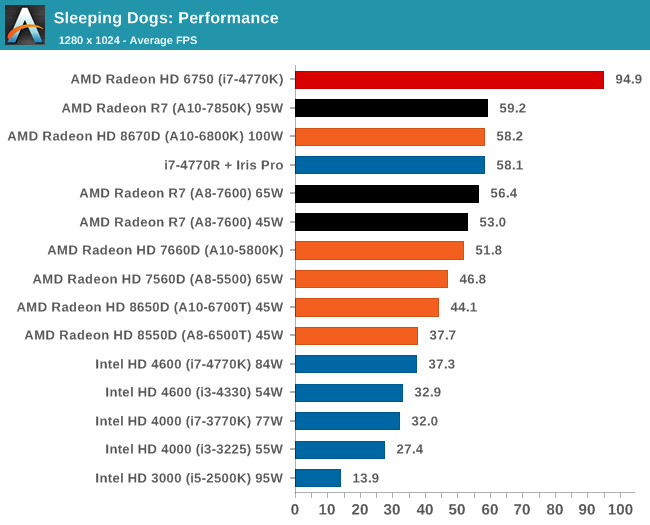
All the AMD APUs tested for this review manage to go above 30 FPS for Sleeping Dogs, with the top end APU nudging at the door of 60 FPS average.
Sleeping Dogs, Quality Settings
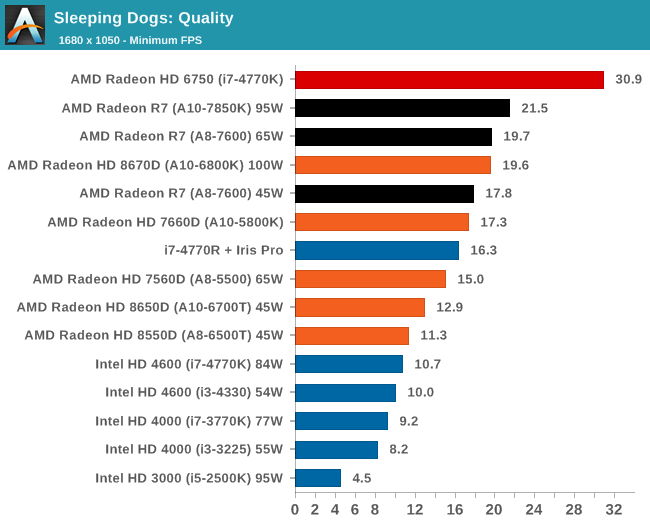
The GCN based Kaveri take the top two IGP spots, and Iris Pro is moving down the list by comparison.
Sleeping Dogs, Xtreme Settings

Iris Pro struggles a lot at 1080p in Sleeping Dogs.
Integrated GPU Performance: Company of Heroes 2
The final gaming benchmark is another humdinger. Company of Heroes 2 also can bring the house down, even at very basic benchmark settings. To get an average 30 FPS at any settings using integrated graphics is a challenge, let alone a minimum frame rate of 30 FPS. For this benchmark I use modified versions of Ryan’s batch files more suited for integrated graphics: 1280x1024 on minimum; 1680x1050 on Low and 1920x1080 on Medium.
Company of Heroes 2, Performance Settings
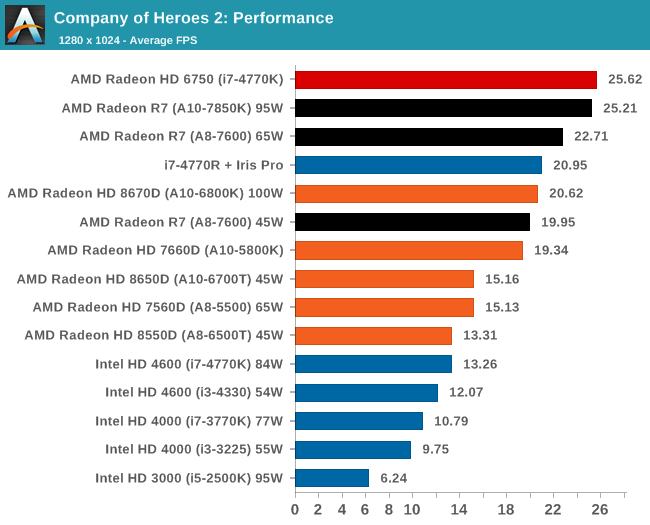
COH2 is demanding enough that even at 1280x1024 and low settings, no platform we tested today can hit 30 FPS average. The 95W Kaveri part does however outshine Richland by almost 25%.
Company of Heroes 2, Quality Settings
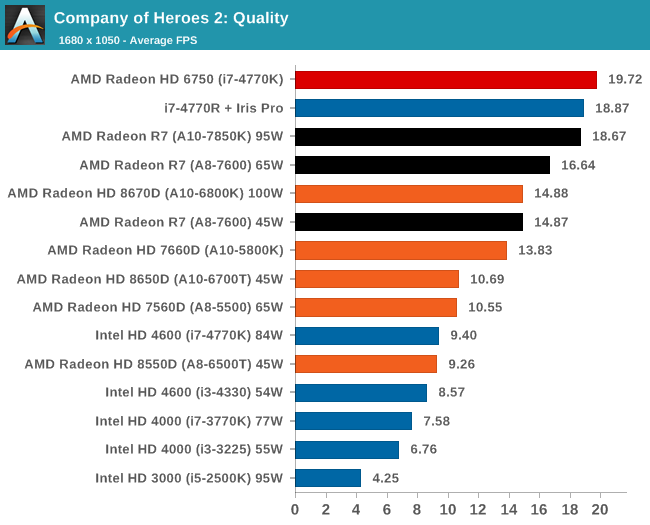
Company of Heroes 2, Xtreme Settings
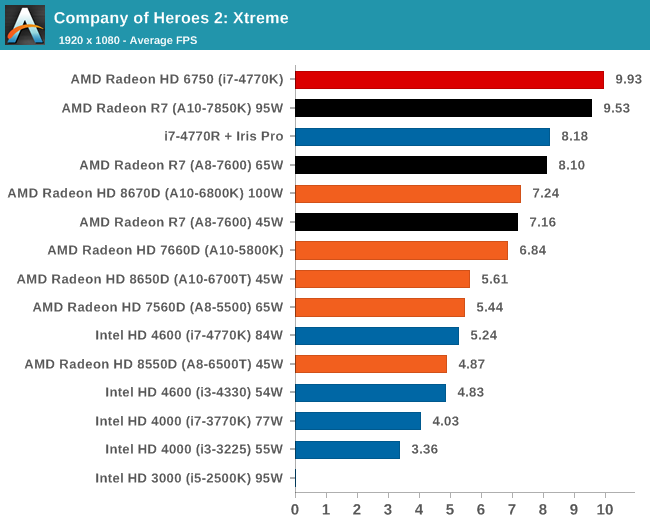
With COH2 extreme settings, the Intel solutions are moving up the minimum FPS ranks to beat AMD.










380 Comments
View All Comments
jjj - Tuesday, January 14, 2014 - link
lol now that AMD is paying you,you jumped at the other extreme , what do you get over Richland and how does that deserve a positive conclusion? (and maybe a reminder is needed A10-6800K is 140$)Drumsticks - Tuesday, January 14, 2014 - link
The author recognized that 100W TDP isn't really any different...? The 45W more mainstream range is where things are a lot more interesting, but please, ignore the 30+% gains.Conduit - Tuesday, January 14, 2014 - link
I have been waiting almost 2 years for a mobile Kaveri telling myself the wait will be worth it. Looks like it actually may be as Kaveri performs better at lower TDP's than Trinity and Richland.Hubb1e - Tuesday, January 14, 2014 - link
This guy actually gets it. These should make very nice cheap laptops able to actually play a game or two without vomiting all over themselves. At 95W the gains are not there, but at 45W it's impressiveJDG1980 - Tuesday, January 14, 2014 - link
What an odd choice of benchmarks. Why not use Photoshop (which supports OpenCL and is an important real-world application) instead of Agisoft (who?) I can't help but wonder if Agisoft paid for their inclusion in Anandtech's benchmark suite.ddriver - Tuesday, January 14, 2014 - link
You may notice that the entire review is not exactly OpenCL compute rich... I mean even for gaming cards AT usually includes several OpenCL benchmarks, but not for this product, where it is supposed to be its strongest point???Conduit - Tuesday, January 14, 2014 - link
I have to say, the 45W A8-7600 kicks ass. It's competitive with the 100W A10-5800K, I think that's where the benefit of Kaveri lies, in the low TDP department.UtilityMax - Tuesday, January 14, 2014 - link
Indeed. However, I personally would like to see benchmarks that measure the power draw. The 65watt TDP Richland A10s were nearly as power thirsty as the +100watt TDP parts. A8 does look interesting.thegreatjombi - Tuesday, January 14, 2014 - link
Any chance we can get HD5200 and HD5400 benches? The 5000 series has started to catch up with AMD in terms of GPU Compute. I am curious if AMD has left Intel in the dust once again, or has Intel actually made a big enough leap to stay in the game.thegreatjombi - Tuesday, January 14, 2014 - link
Oh! It seems the 5000 series is just omitted in the CPU Performance benchmarks? Why is that?